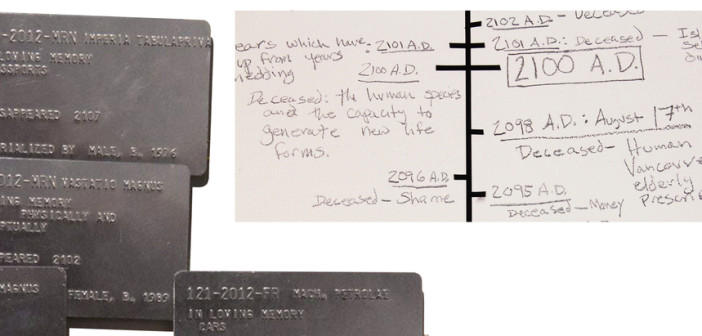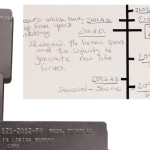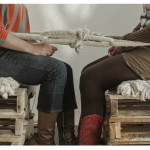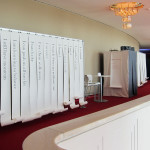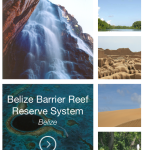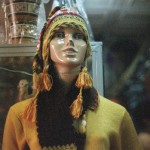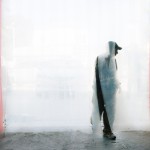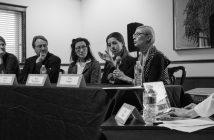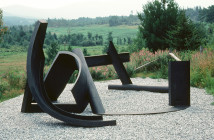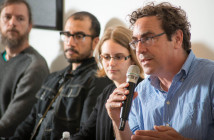In my continuing exploration of art’s role in the branding of Boston as an "innovation hub," I was eager to speak with Boston artists. While the diversity of artists working in Boston makes it nearly impossible to construct a comprehensive portrait of artists’ perspectives, I wanted to consider the range of Boston’s art making in contrast to much of the innovation hub rhetoric, which refers only vaguely to artists and other "creative workers," often implicitly privileging certain forms of art over others. To this end, I asked artists working in a range of media and methods — performance and public intervention artist Andi Sutton, sound artist Halsey Burgund, and Oscar Diaz, Ximena Izquierdo Ugaz, and Bryan Rodriguez of artist collective ¡Qué Lástima! — to add their voices to the discussion.
As noted in my last post, "knowledge production" lies at the core of the innovation hub concept. In our exchanges, Sutton, Burgund, and the members of ¡Qué Lástima! varied in their thoughts on this concept, but collectively illustrated the importance of new ideas in their practices. Both Diaz and Izquierdo Ugaz pointed out the research elements of their work, from creating a database of artists from Central America and its diasporas to discussing topics that academia frequently ignores. Burgund remarked that his general avoidance of the didactic makes his work feel distinct from "knowledge with a capital K," but continued, "on the other hand, new ideas are absolutely central to the way I think about my work….Without the generation of new ideas for myself and the participants, I think my work would essentially be a failure."
Beyond the question of producing knowledge, the artists echoed much of the innovation hub’s language on exchanging ideas and fostering open conversation in their comments on their work. Sutton, who works with the National Bitter Melon Council as well as on a variety of personal and collaborative projects, stated that the unifying structure of these projects was the process of building bridges between ideas, cultural frameworks, and individuals, describing the role of artists as pollinators and as producers of "knowledge that allows for whimsy and questioning." She also noted the role of art in allowing us to "practice" ways of relating around difficult issues and to dig into moments of uncertainty, which ultimately spark progress and understanding.
Bryan Rodriguez pointed out that even when ideas are not new, new framings can drive discourse, stating that "before I produce any type of knowledge I have to think about the type of knowledge I and many others are receiving as well. I have to find the right language to talk through a brown lens…this language is not as accessible in my education based space and often doesn’t exist. So we must create it."
This point is crucial as Boston seeks the promise of an "ideas economy" and aims to foster a wider sense of idea exchange; what ideas are missed if the language to express them doesn’t exist or large swaths of perspectives are ignored? In the context of a move toward "crowdsourcing" and wider discourse, artists can play an important role in creating spaces, forms, and languages that allow for this exchange on a more comprehensive level.
Despite their different aesthetic practices and approaches, each of the artists I spoke with regularly engages with their environment and with challenging issues, from personal identity to the use of public resources. Sutton described her work on climate change as a tool for others to use to discuss the fear and hope around the issue, an important step in establishing and actualizing intentions. Izquierdo Ugaz pointed to dialogue as an important element in addressing questions that deserve exploration, viewing collaboration "as a way of dealing with the huge gaps of dialogue often faced in the larger academic/artistic clusters within and outside of Boston." Burgund’s work provides an interesting example of the ways in which artists can add to gaps in dialogue and knowledge; somewhat unexpectedly, he has been working with the Smithsonian to use the software platform he originally developed for his art as a tool for new educational and interpretive museum practices. Burgund noted that at the TEDMED conference, at which he shared an installation he co-created with Kelly Sherman, speakers felt that artists "need to be an integral part of any and all efforts to really move forward and improve society." As evidenced in the practices of the individuals I spoke with, many artists are already thinking and working in ways championed in the language of innovation, and the recognition Burgund describes can foster sharing of these insights across fields.
As Boston moves forward, the city should work to engage deeply with these artists, who reflect some of the city’s greatest strengths. Sutton spoke about the unique rigor that Boston’s university network adds to artistic practice within the city, commenting on the level of thought and exchange this environment provides. While the city is quick to celebrate many products of this milieu, artistic contributions are more frequently ignored or seen as isolated. Burgund noted the opportunities this precludes, stating that artists "would make a positive contribution if they were invited into the mix in a constructive way."
The comments of members of ¡Qué Lástima!, in particular, stressed the need to extend these invitations beyond familiar circles or those tied to short-term economic benefits. Diaz, Izquierdo Ugaz, and Rodriguez discussed the complications surrounding their relationship with the innovation hub, particularly given continuing marginalization and hegemonic institutional structures. Izquierdo Ugaz brought up innovation’s relationship to art mediums that create creative and emotional, rather than economic, capital, while Diaz commented on the difficulty of navigating the city’s various "micro-hubs," asserting, "Boston has a lot of serious work to do to better include the QTPOC community into the hub."
 Andi Sutton, Conversation in Memorial, 2011. Seed tags and notes documenting extinctions shared by performance participants Installation and dialogue-based performance. Image: Andi Sutton.
Andi Sutton, Conversation in Memorial, 2011. Seed tags and notes documenting extinctions shared by performance participants Installation and dialogue-based performance. Image: Andi Sutton.These comments demonstrate the need for Boston to engage with artists to a degree that transcends lip service and involves a wide range of voices. Artists’ approaches to challenging problems speak to an element of Boston’s heritage that makes it uniquely suited to serve as an innovation hub — as Sutton pointed out, the language of innovation can seem singularly focused on progress, but it also encompasses underpinnings of intellectualism, curiosity, and questioning, concepts which have long formed part of the city’s identity. "My hope for this urban branding is that it will be a challenge, not a statement of arrival," Sutton remarked near the end of our conversation. If Boston wants to meet the challenges of innovation, imagination, and creative thinking, it would do well to consider the contributions of its artists.
- Andi Sutton, Conversation in Memorial, 2011. Seed tags and notes documenting extinctions shared by performance participants Installation and dialogue-based performance. Image: Andi Sutton.
- Andi Sutton, Conversation in Memorial, 2011. Installation detail: dialogue-based performance in woven furniture. Image: Josh Dreyfus
- Halsey Burgund & Kelly Sherman, Patient Translations installation at TEDMED, Kennedy Center, DC – Two visual installation halves flanking the central recording booth. (photo credit: Kelly Sherman)
- Halsey Burgund, screenshot from an in-process version (ie. unfinished and not yet released) of an app for a Smithsonian/UNESCO collaboration.
- Ximena Izquierdo Ugaz and Bryan Rodriguez (collaboration), Sin Titulo 2013, Performance/Photo
- Genesis Baez, Untitled, 2011.

